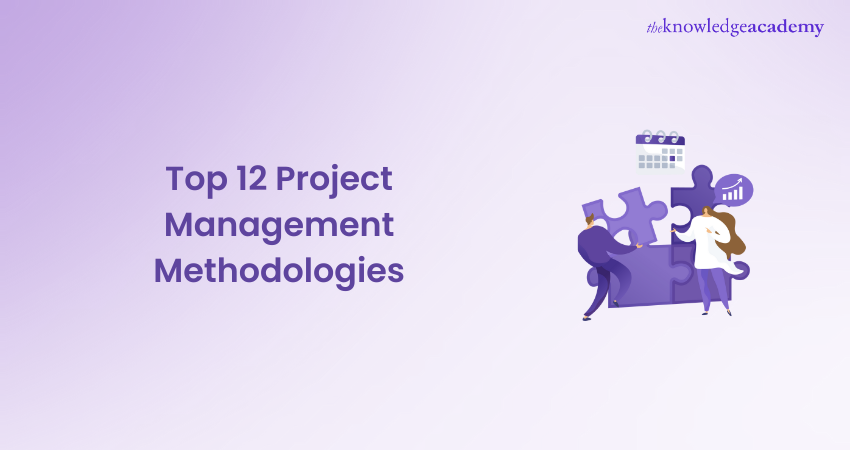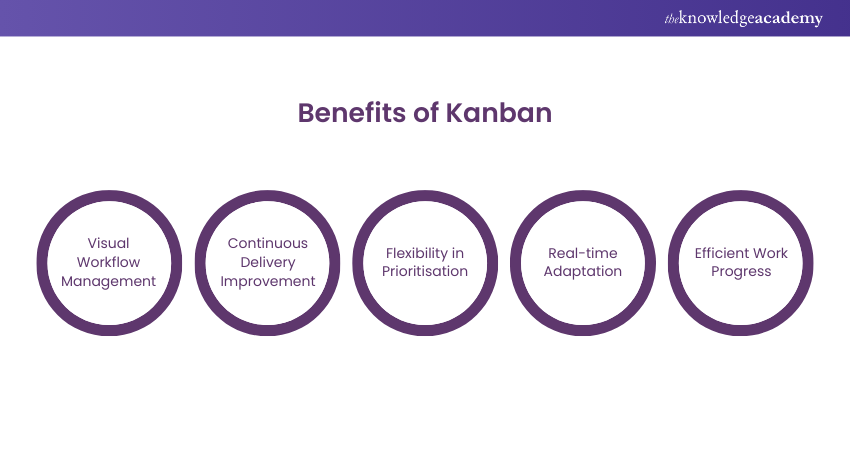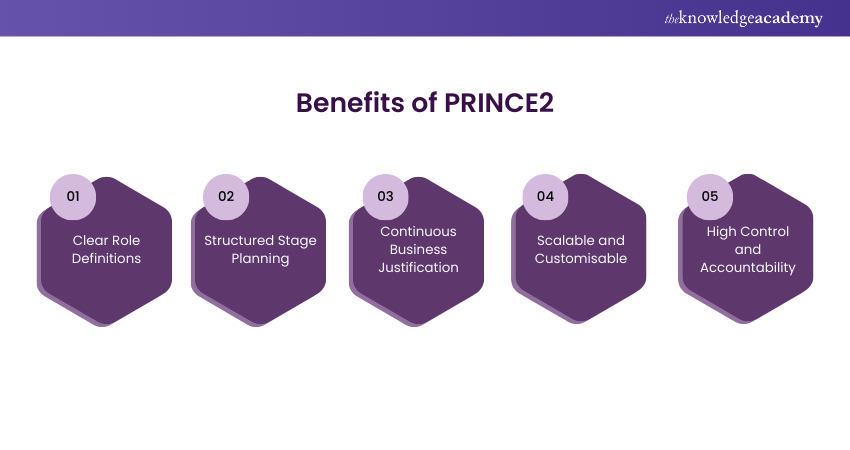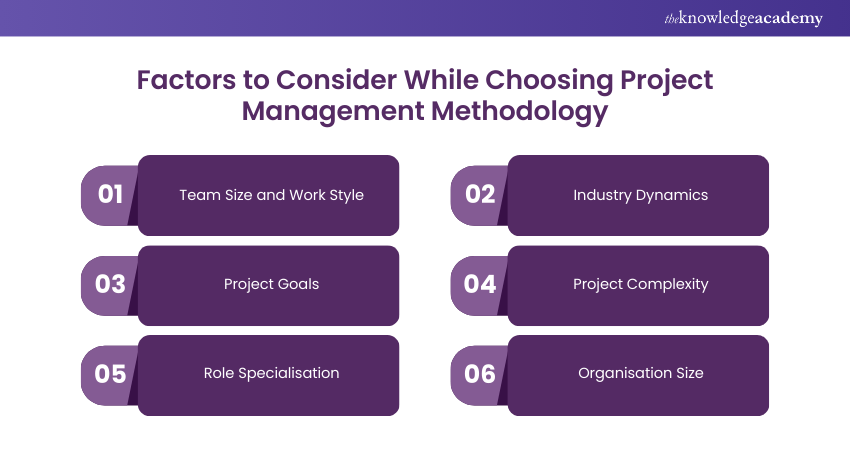We may not have the course you’re looking for. If you enquire or give us a call on +44 1344 203 999 and speak to our training experts, we may still be able to help with your training requirements.
We ensure quality, budget-alignment, and timely delivery by our expert instructors.

Choosing the right Project Management Methodologies can make all the difference in how smoothly your projects run and how successful they are. With so many options available, it’s important to understand what each methodology offers and how it can benefit your team.
In this blog, we discuss some of the most popular Project Management Methodologies, providing tips on how to choose the best one for your team's unique needs. Whether you're working with a small, specialised team or a large, dynamic group, this blog helps you find the right approach to ensure your projects succeed.
Table of Contents
1) What is a Project Management Methodology?
2) 12 Project Management Methodologies
a) Waterfall
b) Kanban
c) Lean Methodology
d) Critical Path Method (CPM)
e) Critical Chain Project Management (CCPM)
f) Project Management Institute's PMBOK® Guide
g) Extreme Programming (XP)
h) Agile
i) PRINCE2
j) Six Sigma
k) Scrum
l) Scumban
3) Choosing the Right Project Management Methodology for Your Team
4) Conclusion
What is a Project Management Methodology?
Project Management methodology is a structured approach that outlines the processes, techniques, and tools used to manage and complete a project successfully. It offers a framework for planning, executing, and monitoring project tasks, ensuring that objectives are met within the constraints of time, budget, and resources. Project management trends often highlight new methodologies and tools that can improve the management and execution of projects.
Different methodologies, such as Agile, Waterfall, and PRINCE2, offer various strategies for managing projects based on the needs and goals of the project.
12 Project Management Methodologies
Let's explore 12 popular methodologies, each offering unique strategies to help teams achieve their project goals.
1) Waterfall
This methodology is a linear and sequential approach to Project Management. It involves completing each project phase, such as planning, design, development, testing, and deployment, one after the other. Once a phase is completed, you move on to the next, and going back to make changes is difficult.
This method is ideal for projects with clearly defined requirements that are unlikely to change. The Waterfall approach, as outlined in the Waterfall Project Management PDF Guide, is simple to understand and manage, with each phase having a set deliverable.
When to use it: Use Waterfall when the project has well-defined and stable requirements from the start. It’s best suited for projects where changes are unlikely, such as construction or manufacturing.
2) Kanban
It is a visual Project Management method that focuses on continuous delivery without overburdening the team. It uses a Kanban board with columns representing different stages of work, and tasks are moved through the stages as they progress. Kanban encourages flexibility, allowing teams to prioritise and adapt to changes in real-time.

There are no fixed iterations, which makes it ideal for projects where priorities can change frequently. It’s particularly useful for managing work in progress and improving workflow efficiency.
When to use it: Use Kanban when you need a flexible approach that allows for continuous delivery and adaptation to changing priorities. It's ideal for projects with ongoing tasks, such as software maintenance or support.
Learn the Kanban process with our Certified Kanban Foundation Training – Join today!
3) Lean Methodology
Lean methodology focuses on maximising value while minimising waste in the project process. It emphasises delivering value to the customer through continuous improvement and efficiency. Lean uses techniques like Just-In-Time (JIT) production and aims to eliminate anything that does not add value to the project.
It’s a customer-focused approach that seeks to streamline processes and improve quality. Lean can be applied to various industries, from manufacturing to software development.
When to use it: Use Lean when you need to optimise efficiency, reduce waste, and focus on delivering maximum value to the customer. It’s best for projects where improving processes and minimising waste are key objectives.
4) Critical Path Method (CPM)
It is a Project Management technique used to identify the sequence of essential tasks that determine the project’s duration. CPM involves mapping out all tasks and estimating their durations. It then determines the critical path, which is the longest sequence of tasks that must be completed on time for the project to be finished on schedule.
CPM helps identify the most crucial tasks and potential bottlenecks. By focusing on the path, Project Managers can allocate resources to ensure timely project completion.
When to use it: Use CPM for projects with interdependent tasks where understanding the project timeline is crucial. It’s ideal for complex projects with tight schedules, such as construction or engineering projects.
5) Critical Chain Project Management (CCPM)
Critical Chain Project Management (CCPM) builds on the Critical Path Method by incorporating resource availability into the scheduling process. It emphasises the importance of resource management, focusing on the tasks that can be completed given the availability of resources.
CCPM involves adding buffers to protect the project timeline from delays. It’s a method designed to keep projects on track even when uncertainties or resource constraints arise.
When to use it: Use CCPM when resource constraints are a significant factor in the project scheduling process. It’s best suited for projects where managing resources efficiently is critical to meeting deadlines.
6) Project Management Institute's PMBOK® Guide
Ready for an international business career? Start with the Global Management Program!
The PMBOK® Guide by the Project Management Institute (PMI) is a comprehensive collection of best practices, standards, and guidelines for Project Management. It covers various elements of Project Management, including scope, time, cost, quality, human resources, communications, risk, and procurement management.
PMBOK provides a structured approach and a common language for Project Managers. It’s widely recognised and used across industries as a standard for managing projects effectively.
When to use it: Use PMBOK® when you need a standardised approach to Project Management that is recognised globally. It’s ideal for projects that require a formal and structured process, especially in industries like construction, IT, and finance.
7) Extreme Programming (XP)
It is a software development methodology that emphasises customer satisfaction, continuous feedback, and frequent releases of functional software. XP involves practices like pair programming, test-driven development (TDD), and continuous integration.
The methodology is highly adaptive, allowing teams to respond quickly to changes in requirements. XP encourages close collaboration between developers and customers to ensure the product meets the customer’s preferences.
When to use it: Use XP for software development projects where requirements are expected to change frequently, and customer feedback is crucial. It’s ideal for projects that need rapid development and frequent updates.
8) Agile
It is an approach to Project Management that delivers small, usable parts of a project in regular, repeated cycles. This helps in making continuous improvements and adjustments. It promotes flexibility, collaboration, and customer feedback in the development process. Agile projects are split into short cycles called sprints, with regular reviews and adjustments.
The methodology is highly adaptive, allowing teams to respond to changes and deliver value faster. Agile is commonly used in software development but can be applied to other fields as well.
When to use it: Use Agile when you need to deliver projects in stages, with the flexibility to adapt to changing requirements. It’s best suited for projects with evolving goals or when customer feedback is vital.
9) PRINCE2
PRINCE2 (Projects IN Controlled Environments) is a process-based Project Management methodology that focuses on clearly defined roles, stages, and controls. It provides an approach with a detailed plan for each stage of the project, emphasising the need for continuous business justification.

PRINCE2 is scalable and can be customised to fit projects of any size or complexity. It’s widely used by governments and private sectors, particularly in the UK and Europe.
When to use it: Use PRINCE2 for projects that require a high level of organisation, control, and accountability. It’s ideal for large, complex projects that need a structured and methodical approach.
Learn how to apply PRINCE2® principles with our PRINCE2® Foundation Course – Join today!
10) Six Sigma
Six Sigma is a data-driven methodology focused on improving quality by finding and eliminating defects in processes. It uses statistical analysis and a set of quality management tools to improve processes, reduce variability, and increase efficiency.
Six Sigma follows a defined sequence of steps known as Define, Measure, Analyse, Improve, Control (DMAIC) to achieve its goals. It’s commonly used in manufacturing but can be applied to any process-oriented industry.
When to use it: Six Sigma is used when the primary goal is to improve process quality and efficiency by reducing defects. It’s ideal for projects in manufacturing, logistics, or any area where process optimisation is critical.
Learn the basics of Six Sigma with our Six Sigma Green Belt Course – Join today!
11) Scrum
It is an Agile framework that helps teams work together to develop, deliver, and sustain complex products. It emphasises teamwork, accountability, and iterative progress toward a well-defined goal. Scrum uses roles like Product Owner, Scrum Master, and Development Team, along with ceremonies like daily stand-ups, sprint planning, and sprint reviews.
It encourages continuous improvement and flexibility, making it easier to adapt to changes and deliver value quickly.
When to use it: Use Scrum for projects that require frequent updates and close collaboration among team members. It’s best suited for projects in software development, where iterative progress and flexibility are key.
12) Scrumban
It is a hybrid methodology that combines the structure of Scrum with the flexibility of Kanban. It uses the roles and ceremonies of Scrum, such as sprints and daily stand-ups, while incorporating Kanban’s visual workflow management and focus on continuous delivery.
Scrumban allows teams to maintain the discipline of Scrum while adapting to changing priorities in real time. It’s an excellent choice for teams transitioning from Scrum to Kanban or for those needing a more flexible approach within an Agile framework.
When to use it: Use Scrumban when you need the structure of Scrum with the flexibility of Kanban. It’s ideal for projects where priorities may shift, and continuous delivery is important.
Enhance Project Tracking Efficiency – Get your Earned Value Management PDF today!
Choosing the Right Project Management Methodology for Your Team
There’s no one-size-fits-all approach to Project Management. Each methodology offers its own unique principles to guide a project from the planning stage to final execution. When choosing the right method for your team, consider these key factors:

a) Team Size and Work Style: Think about how big your team is and how they prefer to work together. The methodology you choose should align with your team's dynamics and collaboration style.
b) Industry Dynamics: Consider if you work in a rapidly changing industry, like technology. This will impact the consistency of your projects and whether you need a flexible or more rigid methodology to manage these changes effectively.
c) Project Goals: Reflect on your project objectives. If your focus is on people and collaboration rather than just efficiency, choose a methodology that supports these values.
d) Project Complexity: Assess how complex your projects typically are. Some methodologies, like CCPM, are better suited for managing intricate tasks, while others might be more straightforward and less suited for complexity.
e) Role Specialisation: Consider the specialisation of roles within your team. If your team members are highly specialised, you might need a methodology that supports this. On the other hand, if team members can easily switch tasks, a more flexible approach might work best.
f) Organisation Size: The size of your organisation and team plays a big role in deciding on a methodology. Some methods, like Kanban, are versatile and work well for any team size, while others, like CPM, are more suited to smaller teams.
Simplify your project management with ease! Discover how Using Google Calendar as Project Management Tool can boost your efficiency.
Conclusion
We hope this blog has provided you with valuable insights into the various Project Management Methodologies available and how to choose the right one for your team. Remember, the key is to consider your team’s size, work style, project goals, and organisation size. By carefully evaluating these factors, you can select a methodology that aligns with your team's needs, ensuring smoother project execution and better overall results.
Learn essential techniques for project planning with our Project Management Certification Course – Join today!
Frequently Asked Questions
What is the Easiest Project Methodology?

The easiest project methodology is often considered to be Kanban. It is simple to implement, focuses on visualising tasks, and can be easily adapted to different team sizes and types of projects.
How do you Present a Project Methodology?

To present a project methodology, start by explaining its core principles and how it fits with the project's goals. Use clear examples and visuals to show how the methodology will be applied and its benefits for the team.
What are the Other Resources and Offers Provided by The Knowledge Academy?

The Knowledge Academy takes global learning to new heights, offering over 3,000 online courses across 490+ locations in 190+ countries. This expansive reach ensures accessibility and convenience for learners worldwide.
Alongside our diverse Online Course Catalogue, encompassing 19 major categories, we go the extra mile by providing a plethora of free educational Online Resources like News updates, Blogs, videos, webinars, and interview questions. Tailoring learning experiences further, professionals can maximise value with customisable Course Bundles of TKA.
What is The Knowledge Pass, and How Does it Work?

The Knowledge Academy’s Knowledge Pass, a prepaid voucher, adds another layer of flexibility, allowing course bookings over a 12-month period. Join us on a journey where education knows no bounds.
What are the Related Courses and Blogs Provided by The Knowledge Academy?

The Knowledge Academy offers various Project Management Courses, including the Project Management Office Fundamentals Certification, Project Management Certification and CGPM (Certified Global Project Manager) Course. These courses cater to different skill levels, providing comprehensive insights into Global Project Management.
Our Project Management Blogs cover a range of topics related to Project Management Methodologies, offering valuable resources, best practices, and industry insights. Whether you are a beginner or looking to advance your Project Management skills, The Knowledge Academy's diverse courses and informative blogs have got you covered.
Upcoming Project Management Resources Batches & Dates
Date
 Introduction to Project Management Course
Introduction to Project Management Course
Fri 14th Mar 2025
Fri 9th May 2025
Fri 15th Aug 2025
Fri 10th Oct 2025
Fri 12th Dec 2025






 Top Rated Course
Top Rated Course



 If you wish to make any changes to your course, please
If you wish to make any changes to your course, please


